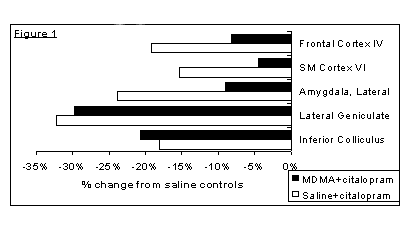| pA2 online © Copyright 2004 The British Pharmacological Society |
135P
GKT, University of London Winter Meeting December 2003 |
|
Previous
exposure to 3,4-methylenedioxymethamphetamine (MDMA) attenuates
local cerebral metabolic response to citalopram in dark agouti rats |
|
Loss of 5-HT nerve terminals and altered local cerebral glucose utilisation (lCMRglu) have been found in Dark Agouti (DA) rats three weeks after a single exposure to 3,4,-methylenedioxymethamphetamine (MDMA) (Quate et al., 2002). In this study we have extended the post-MDMA survival time to six weeks and have challenged animals pharmacologically with the selective 5-HT reuptake inhibitor, citalopram.
Adult male DA rats were injected (i.p.) with MDMA (15mg.kg-1; n=10) or saline (n=10). Six weeks later equal numbers from each group were injected (i.v) with citalopram (10mg.kg-1; n=10) or saline (n=10), ten minutes prior to measurement of lCMRglu using [14C]-2-deoxyglucose quantitative autoradiography (Kelly et al., 1995). Physiological variables were monitored throughout. Data (mean ± s.e.m.) were analysed using t-tests with Bonferroni correction applied when appropriate (p<0.05).
By 45 minutes, citalopram produced significant decreases in rectal temperature (from 37.1±0.3 to 35.7±0.2oC) and heart rate (446±13 to 378±8 beats.min-1) in saline pre-treated rats. In MDMA pre-treated rats, there was a smaller, but still significant reduction in heart rate (450±8 to 417±7), but no change in temperature.
Six weeks after saline or MDMA pre-treatment, there we re no significant differences between groups in either physiological variables or lCMRglu. In saline pre-treated rats, citalopram produced widespread reductions in lCMRglu (15% to 53%), which were significant in 57 of the 58 brain areas analysed. In MDMA pre-treated rats, citalopram also produced decreases in lCMRglu, however, reductions were not only less widespread (significant in only 29 brain areas) but were also generally lower than in saline pre-treated rats (maximum response -30%). Attenuation of the response to citalopram was most notable in areas of neocortex (Figure 1), but was found in anatomical elements of all functional systems in the brain. In contrast, in some areas of the brain (e.g. elements of the limbic system and sensory nuclei) the response to citalopram was quantitatively similar in both pre-treatment groups. (Figure 1).

This study provides evidence that previous exposure to MDMA alters the local cerebral metabolic response to citalopram. If MDMA produces similar persistent effects in humans then a history of drug use might reduce the therapeutic potential of citalopram, or similar drugs, in these people.
Kelly, P.A.T., Ritchie,
I.M., McBean, D.E. et al.(1995) J. Cereb.Blood Flow Metabol.,15,706-713.
Quate, L., McBean, D.E., Ritchie, I.M., et al. (2002) Brit.
J. Pharmacol., 137: 127P.
This study was funded by EC Grant No. QLG3-CT-2002-00809.